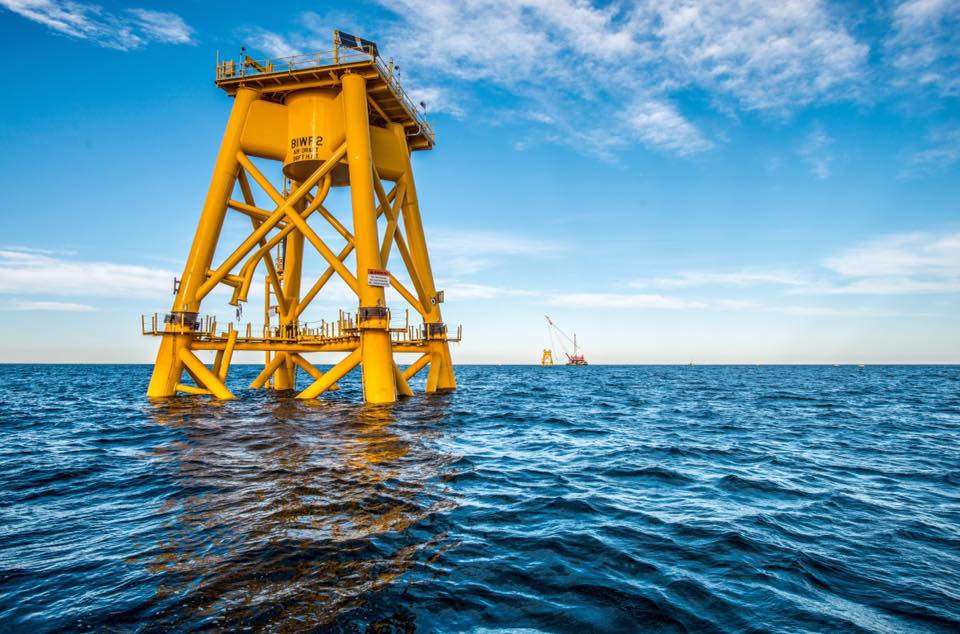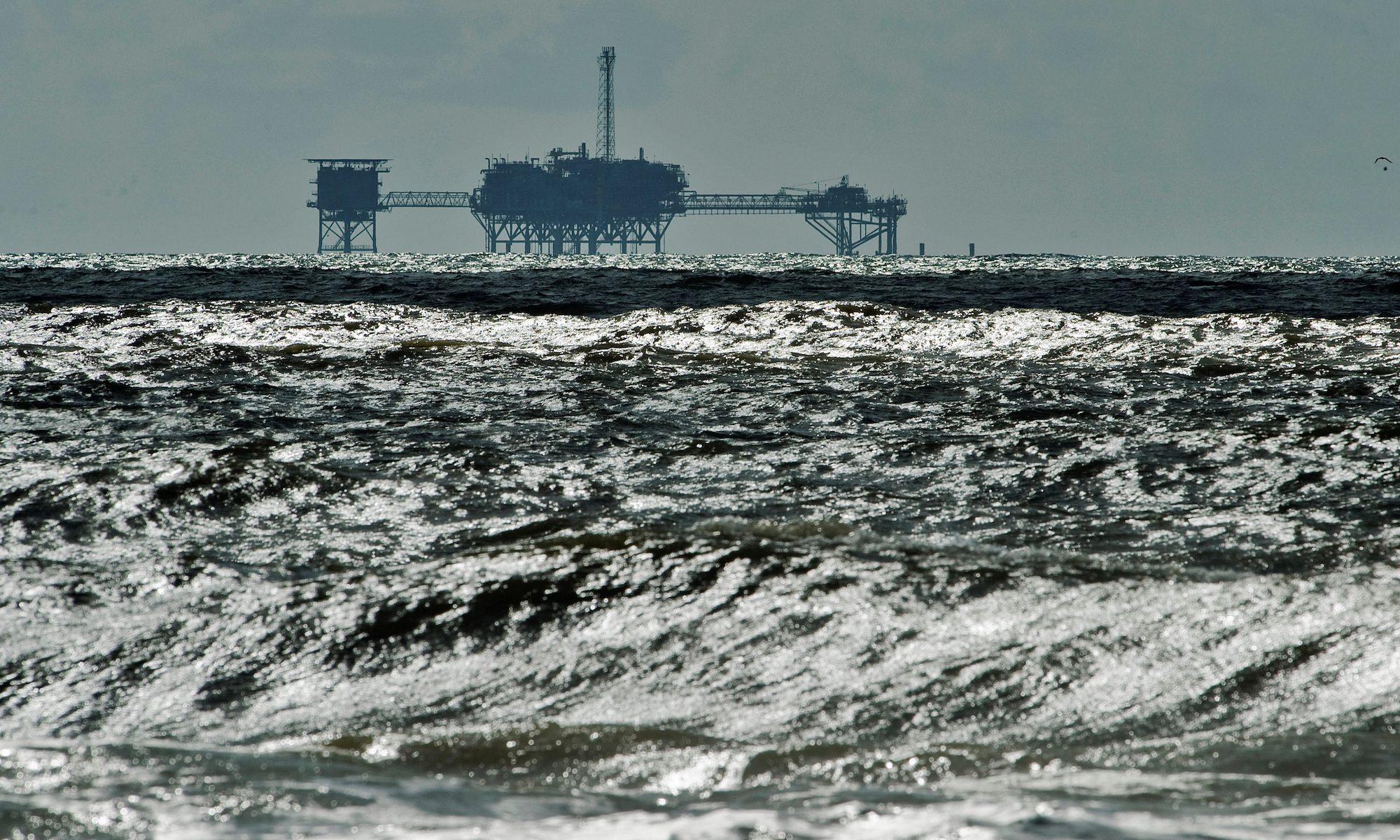One of five jacket foundations now installed at Deepwater Wind’s Block Island Wind Farm site located off Rhode Island. Credit: Deepwater Wind
By Joe Ryan
(Bloomberg) — Lawmakers in Massachusetts are drafting a bill that would jump-start the offshore wind industry in the U.S., helping trigger a $10 billion building spree off the Atlantic coast.
The energy bill may be introduced as early as this month and is expected to require utilities to purchase power from offshore wind farms, according to Representative Thomas Golden, one of the Democrats who control the state legislature.
Still to be determined is how much power utilities would be forced to buy under the bill and, crucially, whether the state’s Republican governor — who has already opposed one offshore project — will sign it.
Developers want legislators to mandate the sale of 2,000 megawatts over a decade, enough to power roughly 1.6 million households. Building the infrastructure to deliver that capacity would cost about $10 billion, said Tom Harries, an analyst at Bloomberg New Energy Finance. It also would give developers their first chance to build the farms on a mass scale outside Europe and Asia, in a region where powerful ocean winds and high energy prices will provide a key proving ground.
“This bill would be the last piece of the puzzle to get the industry going,” said Thomas Brostrom, general manager of North America for Dong Energy A/S, the world’s largest offshore wind developer.
First Project
Three companies — Dong, Deepwater Wind LLC and Offshore MW LLC — have leases from the federal government to build in the waters south of Martha’s Vineyard. Deepwater last year began constructing the nation’s first offshore wind farm off Rhode Island. Dong, meanwhile, has opened an office in Boston anticipating the Massachusetts legislation, and is hunting for further sites along the East Coast.
Massachusetts state Senator Marc R. Pacheco said the prospect of Dong and other companies anchoring their U.S. operations in the state may trigger an economic boom.
“We have the opportunity to create an industry,” Pacheco, a Democrat, said in an interview.“We have the opportunity to create thousands of jobs and create a whole supply chain.”
Globally, offshore wind energy has boomed over the last decade as developers installed turbines with more than 11,000 megawatts of capacity, primarily in the U.K. and Germany, according to Bloomberg New Energy Finance. They’re forecast to install another 12,000 megawatts in those areas by 2019.
Expensive Power
At the same time, U.S. projects have languished as cheap natural gas and plentiful land for ground-based wind and solar farms have elbowed offshore turbines to the bottom of the clean-energy agenda. While the cost of offshore wind energy is falling, it remains one of the most expensive sources of electricity, scaring off utilities as potential customers.
By allowing the facilities to be clustered near each other off the coast of Massachusetts, developers are hoping to lower costs so they can provide power at more competitive rates to existing generators.
“Without those contracts, those power purchase agreements with the utilities, none of the developers can finance their projects,” said Erich Stephens, executive vice president executive vice president of Offshore MW.
Building new power sources is critical in New England. The region is scheduled to lose more than 8,000 megawatts in the next four years as oil, coal and nuclear power plants close. Massachusetts Governor Charlie Baker has pushed to replace closing plants with hydro electricity, introducing a bill last year that would require utilities to seek long-term contracts with hydro companies that could draw as many as 2,400 megawatts from Canada.
Cape Wind
The governor has been less enthusiastic about offshore wind. During an unsuccessful gubernatorial run in 2010, he railed against Cape Wind, a now-stalled attempt to build a 468-megawatt project off Cape Cod. It was maligned as a would-be eyesore and criticized by Baker as a sweetheart deal for the developer.
The new crop of developers plan to build further out to sea, where the turbines wouldn’t be visible from land. Baker, who declined to be interviewed, has indicated he may be receptive.
In March, the governor’s energy secretary, Matthew A. Beaton, said during a speech in Boston that any decision to back offshore projects would hinge on cost. A forthcoming study on cost projections for Massachusetts offshore wind projects would play an important role, according to Beaton. “If advances in offshore wind technology bring a competitive price to the market — then we should embrace this resource,” he said.
Supply Chain
The study, by the University of Delaware, was published two weeks later. It concluded the cost of building wind farms off Massachusetts may decline as much as 55 percent by 2030, allowing developers to offer rates competitive with market prices. The key to lowering costs, the study found, was building a series of projects large enough to develop transmission and construction infrastructure, manufacturing facilities and other elements of a supply chain.
Golden, the Democratic state representative who heads the panel drafting the bill, said it hasn’t yet determined how many megawatts would be called for. The final legislation will probably include support for a broad mix of clean energy, he said.
‘Appropriate Balance’
“Offshore wind has piqued a lot of people’s interest, but at the same time so has hydro,” Golden said. “We need to figure out the appropriate balance.”
The bill would “ignite” the offshore wind industry in the U.S., and may prompt Vestas Wind Systems A/S, the world’s biggest turbine maker, to expand its manufacturing operations in the U.S., according to Stewart Mullin, a spokesman for the Danish company.
“History has shown that a stable and secure order pipeline is a precursor to investment and that the early movers are traditionally the ones that reap the supply chain benefits,” Mullin said in an e-mail.
A spokeswoman for National Grid Plc, Mary-Leah Assad, said the utility, which serves roughly 7 million customers in the U.S. Northeast, wants to incorporate more renewables into its operations but would oppose requirements to buy power from a specific source, regardless of price.
Renewable Resources
“National Grid looks to policy makers to ensure that any new legislation includes a process that will allow all renewable resources to compete,” Assad said in a statement.
The state’s two-year legislative session ends July 31. If the bill fails — or omits support for offshore wind — developers say they will turn to other sites on the East coast. But those proposed projects are years behind the ones in Massachusetts. Time and momentum would be lost.
“This industry would certainly expand to Long Island and metropolitan New York and further down the New Jersey coast,” Deepwater chief executive Jeff Grybowski said. “But we are not as far along there. Massachusetts is on the leading edge.”
© 2016 Bloomberg L.P
Unlock Exclusive Insights Today!
Join the gCaptain Club for curated content, insider opinions, and vibrant community discussions.

 Join The Club
Join The Club













